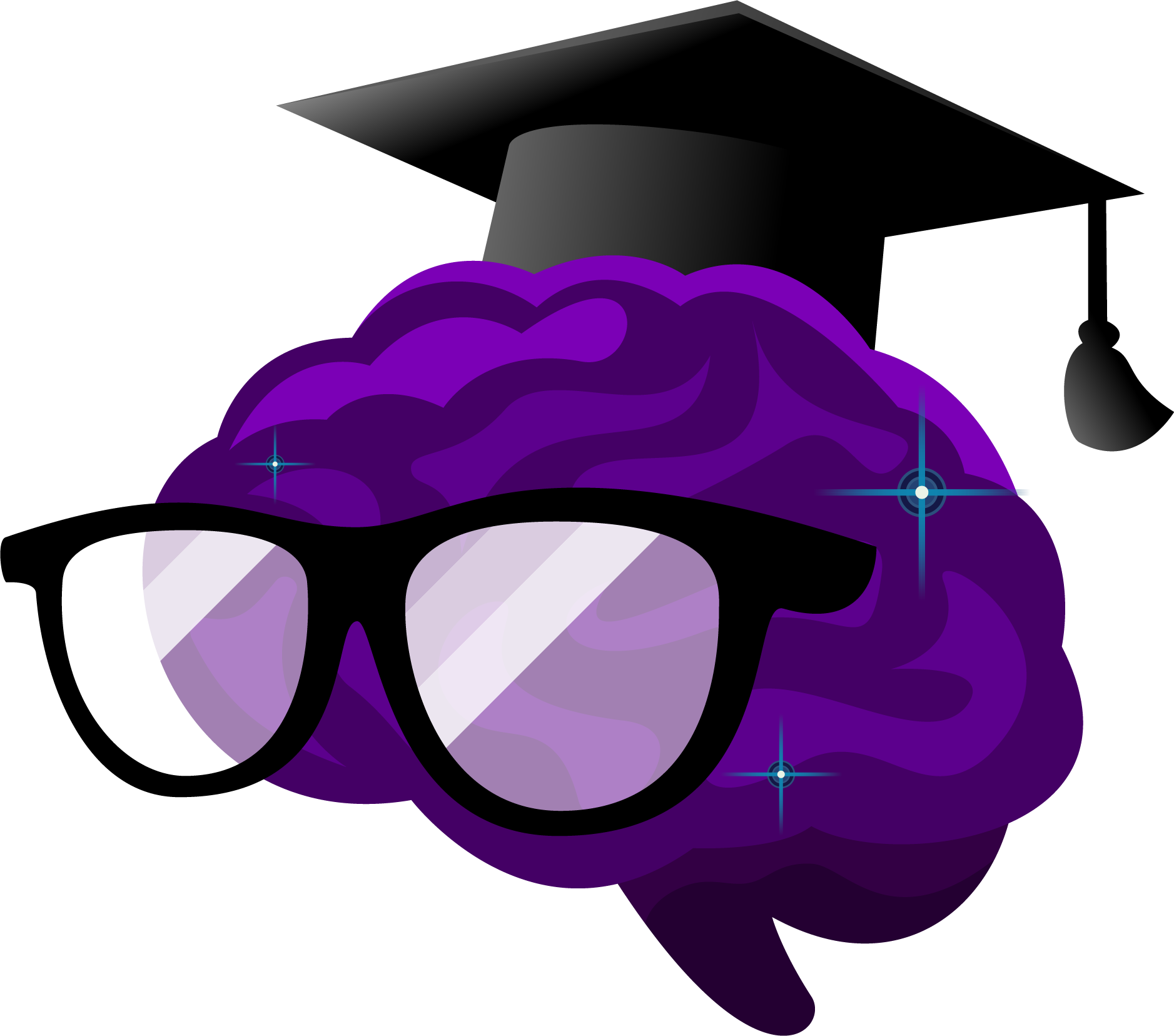Aidan's Infinite Play 35 The Ultimate Beginners Guide To Starting A Zettelkasten In Obsidian As A Student

Hello players!
It's not enough to go to school and get a degree anymore.
Here's the issue: in the digital age, your perspective and ability to learn fast matters more than your rote knowledge. Not only is there more information than ever before, but new information is coming out faster than ever before. Physical colleges can't keep up.
A physical college degree simply doesn't prepare you for the digital world anymore.
As AI systems get better and better and more and more tasks get automated, your unique perspective as a human being is becoming increasingly important. We live in a paradox of abundance. The quality of good information is getting higher, while at the same time, the quality of bad information is getting worse.
Your hobbies, skills, abilities, relationships, and so much more combine to form something no other human being has.
The issue is traditional schooling is still built on an industrial-era model. It's trying to make you into the perfect factory worker, sucking away your unique perspective.
It's making you a cookie-cutter student.
The future belongs a new type of student. A student that loves learning for the sake of learning in itself. A student that not only can learn incredibly fast, but can imbue their own unique perspective into their notes.
The future belongs to the New Era Student.
The question is how do you make the journey to become a new era student?
That's where this guide comes in.
I'm going to teach you a system of notetaking that heightens your creativity, speed of learning, and makes learning fun again.
"Creativity is just connecting things. When you ask creative people how they did something, they feel a little guilty because they didn't really do it; they just saw something." - STEVE JOBS
You don't need to be a genius.
As you will see, maintaining this system can take 15-30 minutes daily.
Who Is This Guide For?
Anyone who has experienced these problems:
- Do you feel there is an overwhelming amount of information, and you don't know how to organize it all?
- Do you struggle to synthesize your notes into meaningful, cohesive knowledge?
- Are you a student looking to learn the best practices, mindsets, and tools in Obsidian to supercharge your learning?
- Do you lack a systemized process for notetaking?
- Do you struggle to find enjoyment in school learning?
- Do you feel you're not creative?
- Do you start a new semester with no recollection of what you learned in the last?
Do any of these sound familiar?
If so, a Zettelkasten can help.
In this guide we will explore:
- What A Zettelkasten Is
- The Benefits Of Creating One
- The Five Principles Of Building One
- The Zettelkasten Workflow In Obsidian
- Collect
- Connect
- Create
- Troubleshooting and Tips For The Zettelkasten
- 6 Tips for Maintaining a Healthy Zettelkasten
- The Zettelkasten Transformation
⚛️IMPORTANT! I will not be teaching how to use Obsidian. There are plenty of great videos and articles out there on how to do that.
Instead I will be explaining how to build a Zettelkasten inside of Obsidian.
What is a Zettelkasten?
A Zettelkasten (German for "slip box" or "card index") is a note-taking and knowledge management system developed by German sociologist Niklas Luhmann.
At its core, a Zettelkasten is a collection of three main types of notes: fleeting notes (notes on fleeing thoughts), literature notes (notes taken from resources like books, articles, etc.), and permanent notes--which I have rebranded as concept notes (notes with one focal idea that often have literature notes backing them up). You don't have to remember these three types of notes now. We will discuss how they work later.
Using the system, Luhman was what can only be described as "disgustingly prolific."
Over the course of his career, Luhmann created an extensive Zettelkasten containing tens of thousands of individual notes and writing 70 books and hundreds of articles and essays.
Holy smokes.
Who Am I?
Hi!
I'm Aidan Helfant, a Cornell Student studying psychology and creating content on the side.
As a kid, I was addicted to video games and YouTube like a fish is addicted to water.
Every day after school, I would sprint to my room faster than Usain Bolt and boot up the computer. In the summer months, I could play for seven hours a day without breaking a sweat. My addiction only became worse during the start of the COVID-19 pandemic. My life became a cycle of eating, attending online classes, and playing video games.
I began to wonder what drew me so much to these virtual environments.
The reason was simple.
The real world didn't provide the carefully designed pleasures, the thrilling challenges, and the powerful social bonding I could get in games. The real world was serving me plain broccoli, while games were serving me a delicious pizza. In games, I could fully embrace my childhood curiosity and playfulness. I could explore, create, and learn to my heart's content. Compare this to my offline pursuits like school.
In contrast, the school had killed my childhood curiosity.
In school, I was forced to do endless assignments, tests, essays, quizzes, and homework. Instead of learning for the sake of learning in itself, I learned to get the best grade on the test.
But the worst part about school, by far, was the notetaking. Notetaking brought these thoughts to my head:
- Boredom
- Sadness
- Death
Many, many students are in the same boat as me. We all have some sort of passion outside of school. For me, it was gaming. For you, it might be anime, drawing, or, if your aspire to be like Naruto, practicing martial arts. In comparison, school doesn't provide the same level of engagement we get in our hobbies.
The next question then became, why?
I believe one of the main reasons is students today are becoming what we call cookie-cutter students.
Tell me if this sounds familiar, like a bad case of deja-vu: taking notes in class, I would copy exactly what the professor said verbatim. To study for tests later on, I would read my notes passively.
For most of my life, I was a cookie-cutter student.
Until I found the Zettelkasten system of notetaking in Obsidian.
Building a Zettelkasten gave me and can give you all the benefits mentioned below.
The Benefits of Creating a Zettelkasten
- It makes you more engaged in your learning. You add your own unique personality, flare, PIZAZZZZZZ into your learning. Your knowledge becomes something no other student has. You add your own unique sauce to your burger.
- It promotes critical thinking. A Zettelkasten helps students discover relationships between concepts by connecting ideas through links or references. This promotes the synthesis of knowledge, fostering a holistic understanding of a subject
- Creativity and idea generation. The non-linear nature of a Zettelkasten encourages creative thinking and idea generation. Students can explore new connections, spark insights, and generate innovative ideas by engaging with their notes in a flexible and interconnected manner. Over weeks, months, and years of using a Zettelkasten ideas for what to write about naturally arise. You won't have writers block again.
- Reduced studying: The brain doesn't learn by siloing information into rigid folders. It learns by connecting new information to the past. Emulating this process using conceptual note making means you learn the material better the first time.
- Never start from scratch again. Through connecting, your notes will start to connect class to class, semester to semester. Instead of starting with a blank slate each semester, your knowledge will compound on itself.
- You allow your past, present, and future selves to work together. Notetaking is time travel. When you take notes and connect them to ideas you had in the past, you make open yourself up to using your past self's work for your present self. Marking down a book in the moment, you might not know what it's going to be used for. But years from then, you might go back to that note and find it incredible for something you are working on.
Using my Zettelkasten in Obsidian, I have created all of this in just two years:
- 170 YT videos
- 350 literature notes
- 60 Newsletters
- 60 Blog Posts
- 10 School MOCs
- 12 Non-School MOCs
- 20 Podcast Episodes
My video game addiction disappeared in a matter of weeks.
Real life became the most fun game imaginable.
Now you can do the same. I'm going to show you how to build a Zettelkasten in Obsidian yourself. You might think this will take an insane amount of time to manage.
But the best part is once the system is set up, all it takes to maintain is a simple 15-30 minute a day check-in. Your daily coffee run. Or your nightly shutdown.
Why Obsidian?
Nikolas Luhman's Zettelkasten was fully analog, and out of all the tons of modern-day knowledge management apps we could choose from, why Obsidian?
I have made my PKM journey from Google Keep to Notion, to Evernote, to Roam Research, and finally to Obsidian. I have been around the block and back with notetaking apps. Of course, I'm a little biased, but by far the best one I have used is Obsidian.
Obsidian makes me feel free, alive, godly, when I use it.
There are five main reasons:
- It's way easier to maintain
- It's incredibly customizable
- Its link based system allows you to scale knowledge across semesters
- You own your knowledge
- The community is incredible
1. It's way easier to maintain than a physical Zettelkasten.
You don't have to write down everything by hand.
You don't have to buy a literal warehouse to store your notes. The most space your Obsidian database takes is few megabytes on your local hard drive.
2. The customizability is incredible.
Obsidian is essentially just notes connected to other notes.
But through adding core and community plug-ins to your vault, as well as creating your own linking, tag, and folder system, you can create an entirely personal system of knowledge management.
3. Obsidian organizes notes through links.
The main power of a linked-based knowledge management system is you can connect concepts together in a way that expresses your unique perspective.
As mentioned before, the brain doesn't memorize things by siloing them off into individual folders in your head. It connects things together. So why would you not do the same in your notetaking system?
Linked-based systems allow you to write notes the same way your brain organizes things.
4. You own your knowledge.
All your files in Obsidian are stored as plain text markdown documents on your computer hard drive.
You also have the ability to sync across different devices if you so choose. This makes your notetaking system Antifragile, it gains from disorder.
If Obsidian--or the whole world for that matter--blows up, you can take knowledge knowing that your notes are safe.
5. The community is incredible.
Almost everyone I have met in the Obsidian community is kind-hearted and committed to helping others flesh out their PKM systems.
The discord is active. Nick Milo, in my opinion, the Godfather of the Obsidian community, hosts regular Linking Your Thinking Workshops where he teaches people the basics of PKM in Obsidian in general.
The plug-in developers are constantly at work creating and refining plug-ins for Obsidian. And, of course, you can't forget the content creators like me.
Setting Up Obsidian
Now that you know why Obsidian is such a great spot for a Zettelkasten, let's set yours up in Obsidian.
It will literally take 3 minutes.
As your symbolic new school teacher, here's your first assignment.
1. Download and install Obsidian.
Go to https://obsidian.md/ in your web browser.
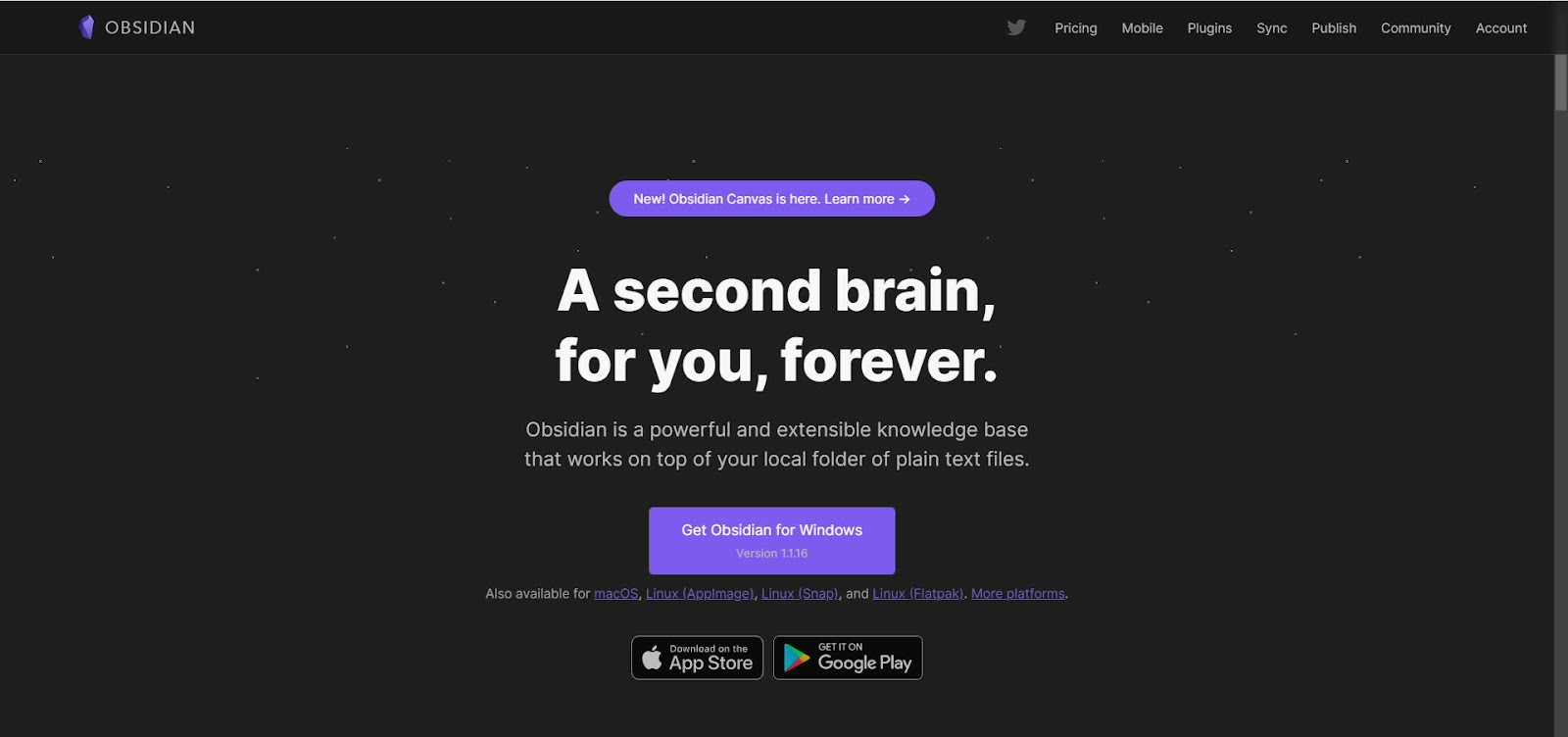
Click on the giant purple button to download it for your OS (It should auto-detect what you have). Once it's downloaded, open the file to install and YAYAYAYAYYAY!
Your computer now has Obsidian.
2. Create a Vault
Now, when you run Obsidian, you'll be prompted with this popup.
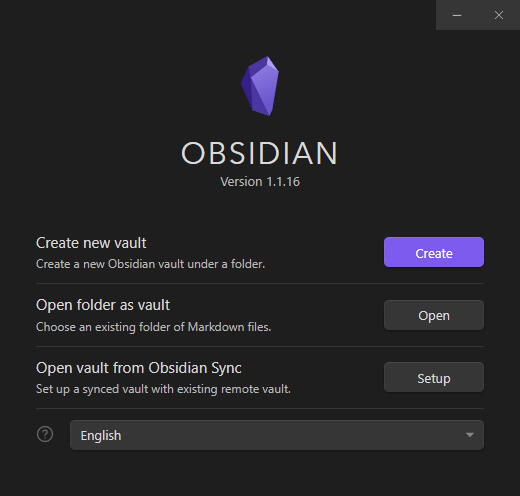
If you're wondering what a vault is, remember earlier we talked about how Obsidian saves your files locally on your computer?
So, a vault, essentially, is just a folder where Obsidian will keep all your notes.
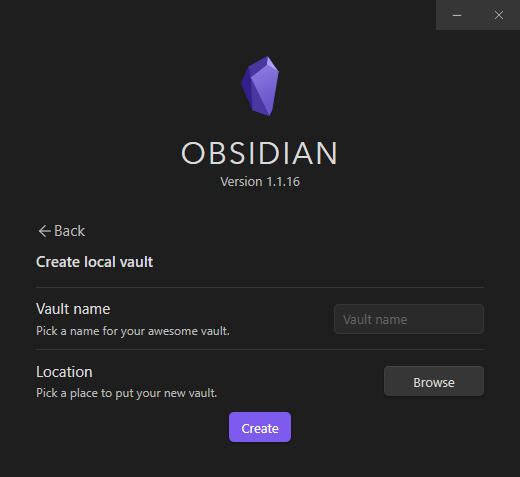
On the next screen, for the Vault name, write "The Best School Zettelkasten" ever made or something.
You can always change it later.
Then, click browse to pick the location on your computer where you'd like all your notes to be saved.
And congratulations! You're Obsidian is live!
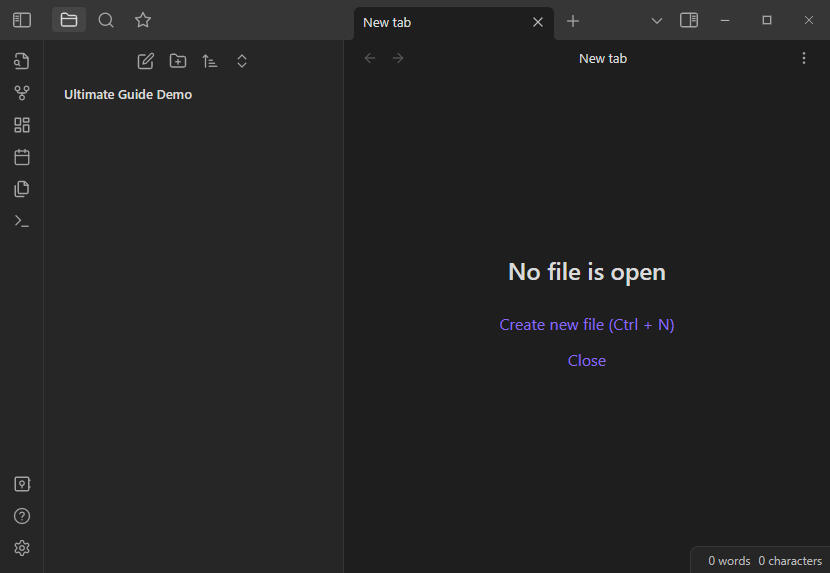
Now let's create seven folders inside of your vault.
Remember, this is the structure I use to create my Zettelkasten. But that doesn't mean a different structure won't work for you. It's essential you play and change this structure to fit your needs.
Create folders titled, +Encounters, Atlas, Calendar, Concept Notes, Literature Notes, Extras, and Spaces.
Your folders will look slightly differently than this because I have the make.md plug in installed allowing me to order folders differently, but the functionality will be the same.
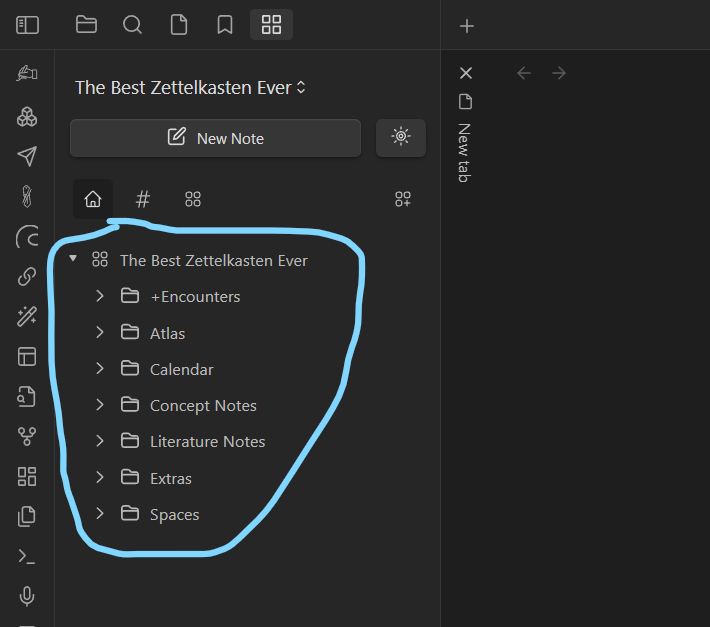
The +Encounters folder is where all of the new notes you create will automatically go. It's your encounter station for new ideas.
Atlas: helps me gather, develop, and navigate ideas. It contains my Maps of Content (MOCs), dashboards, overviews, logs, and datascopes.
Calendar: helps me log, track, and review what matters to me. It contains my time-based information like daily notes, meetings, plans, reviews, and journals.
Concept Notes: This folder contains all of my concept notes.
Literature Notes: helps me build my external library of ideas. It contains my literature notes on articles, books, podcasts, research papers, courses, talks, Movies+TV, videos, and Tweets.
Extras: helps me keep my support material handy. It contains attachments, graphics, images, manuals, and templates.
Spaces: helps me keep track of my most important areas of life, schoolwork, and the things I create from my notes for content creation.
Before we go into the workflow of using these folders, let's discuss some principles of building a Zettelkasten in Obsidian.
5 Principles of Building a Zettelkasten in Obsidian
If there is one thing that makes you fail to build a Zettelkasten in Obsidian, it's this: you come in with the wrong mindset.
That's because your mindset ultimately decides how the methods and the tool you learn will work. It doesn't matter how good your methods are or the tool you are using them with if you don't have the correct mindset. So before we learn the workflow of the Zettelkasten in Obsidian, we will learn the mindsets of the new-era student. To do so, we will explore:
- The New Era Student Pyramid
- The Five Mindsets Of The New Era Student
The New Era Student Pyramid
The new era student pyramid encapsulates the areas of importance not only when learning to take notes as a student but for anything in life.
The pyramid shown below is from Bianca Pereira's Build Your Knowledge Portfolio Course, a course that teaches students how to build a knowledge portfolio, a collection of works--books, blog posts, academic articles, videos, etc.--that how you have the knowledge and expertise you claim you have. I highly recommend you check out her course as it has been one of the most influential in my own thinking toward PKM!
The lower parts of the pyramid are more important, and the higher parts are less.
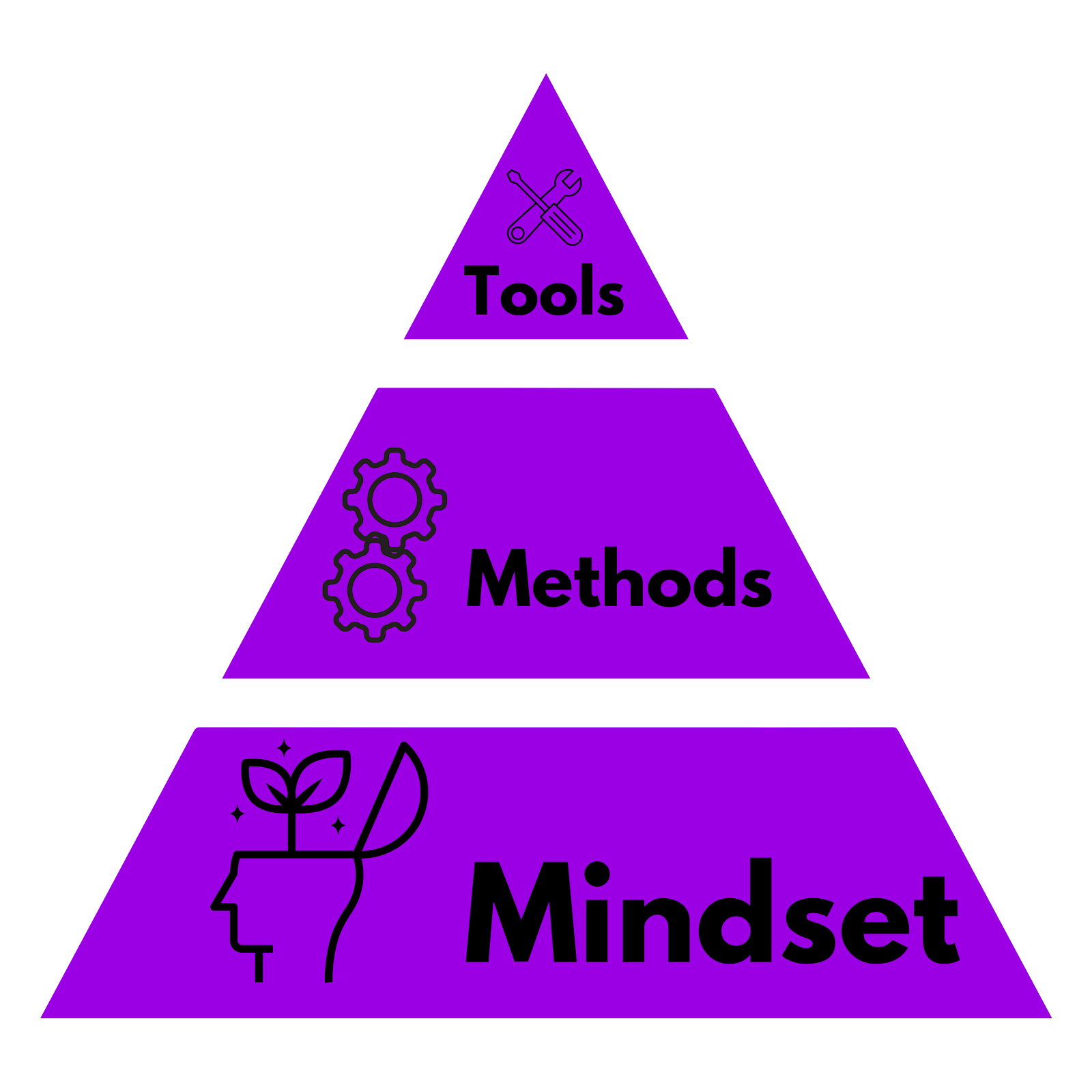
Mindset: the mindset that you bring to your PKM. It will change depending on your goal. Are you trying to create essays out of your notes, study, or something else?
Methods: the procedure and workflow you use to go about doing your PKM. For example, Capture, Organize, Distill, Express from Tiago Forte or Active ideation from Nick Milo. In this article, the method is The Three Cs Of Knowledge Management: collect, connect, create. But there are methods inside of that broader method we will teach as well.
Tools: the apps and other things you use to action your methods and mindset. Next time you struggle using a tool, ask yourself, "Is the tool hard to use, or is it just implementing a different mindset?**"
Mindsets Of The New Era Student
1. Notes Are Pieces Of Understanding Rather Than Pieces Of Truth
The new era student sees their notes as pieces of understanding rather than pieces of truth.
Seeing notes as pieces of truth is a problem for three main reasons:
- It keeps people from writing down their thoughts. Thoughts are unlikely to be true, so people think they shouldn't write them down in the first place.
- It doesn't allow notes to evolve. When you see notes as pieces of truth, there is no reason to go back to them and grow them over time. As soon as you write them down, they are finished, done.
- Personal notes are seen as disposable. Because personal notes have your own unpolished thinking, many people see them as trash worthy in comparison to the more fleshed-out work of other researchers and creators whose ideas might also be in their system. Never devalue your thinking.
New-era students see their notes as pieces of understanding, representations of their evolving thinking.
This is great for three reasons:
- It allows us to avoid perfectionism. Our notes don't have to be perfect the first time we create them. It's natural to be uncertain when learning something new. We should be confused at points during the learning process! If we see our notes as pieces of understanding rather than pieces of truth, we can overcome the psychological strain when this occurs.
- It allows us to evolve our notes over time. As we learn more and change our notes change alongside us. Our Zettelkasten becomes a reflection of our changing areas of interest, a reflection of our psychology.
- We value our notes more. Rather than see notes as that boring thing we do during lecture, we start to see them as the core of our learning and creating process.
2. Create Concept Notes Over Document Notes
Most students, when they take notes for class--or anything of that matter--create massive document notes.
The issue with document notes is they don't link well. They are too big. Linking a note called Oceanography with a note called Python doesn't create a meaningful new idea. The point of linking your knowledge is to create meaningful new knowledge and to understand old knowledge.
Linking document-based notes won't foster new understanding and knowledge; it will only create more confusion.
The solution is to create what is known in the Zettelkasten community as permanent notes, but I have rebranded to call concept notes.
Concept notes are notes that focus on only one idea. This doesn't mean they can't be large. It means one idea is the focus of the note, and the other ideas are background contextual or supporting evidence. Because concept notes focus only on one idea, connecting them together creates new meaningful knowledge unlike the document notes most students create.
It's through this linking together of concept notes that your knowledge connects across classes and scales across semesters.
This hilights a key idea of the Zettelkasten method of notetaking.
"There are no rigid disciplines in the universe, only concepts."
All disciplines — Biology, Neuroanatomy, Behavioral Statistics, American History, etc. — are just highly related concepts linked together into a coherent and more easily digestible form. It's through the linking of these highly related concepts, from class to class from semester to semester, that your knowledge base starts to grow. Your Zettelkasten becomes more than the sum of its individual parts.
3. Notetaking Allows You To Clarify Your Thinking
Most students, when they think of notetaking, think of:
- Boredom
- School
- Sadness
- Death
That's so sad, but it's not your fault. The schooling system has taught you to think this way. Most of the time we take notes, we do it in the boring, awful, verbatim style that is so easy to fall into.
As I hope you will realize, the new era student loves notetaking.
They love it not only because it's fun and engaging but because it helps them clarify their thoughts in a way they never thought imaginable.
Thoughts inside the head are jumbled and confused. It's through externalizing them into the world that the new era student gives themself the flexibility to examine and mold ideas into their existing knowledgebase.
4. Notetaking Allows You To Compound Your Thinking
Throughout school, we get taught to memorize vast amounts of information to regurgitate it when the testing day comes.
But this doesn't allow our ideas to grow in any way. When you externalize your thinking into notes, you allow your present self to leverage your past self's thinking. Essentially, notes are just our past selves externalized thinking.
Before notetaking, humans talked to each other through predominantly oral storytelling.
Oftentimes, a few members would build incredible memories using Mnemonics and Memory palaces to remember long stories.
Despite these incredible memory feats, oral cultures can't compound knowledge easily because there is no easy way to compound past thinking. This is why the stepping stone in human innovation is the invention of notetaking. Notetaking changed everything.
Suddenly, we could compound knowledge on itself by writing things down instead of keeping it all in our heads; the very first Second Brains were born.
The new era student understands the power notetaking has to compound thinking and therefore associates notetaking with joy, exploration, and learning rather than boredom, sadness, school and death.
5. You Don't Have To Take Notes On Everything
What!?
Isn't this whole article about taking notes? That's true, but just like taking notes in a misinformed way can cause catastrophe, feeling the need to take notes on everything can become a form of procrastination. Don't turn the act of creating concept notes out of every idea in school into a chore. That's a recipe for spending tens of hundreds of hours creating notes that not only don't help your understanding but you never use.
Instead, I will explain later on, take notes only on information that isn't USE, unimportant, self-explanatory, or easy enough to memorize on the spot.
Only if I find something that isn't USE do I consider taking notes and distilling what my Professor (I'm talking lectures here) said in my own words.
This way, I don't spend countless hours taking useless notes and can spend more of my time enjoying what I'm learning.
The Zettelkasten Workflow In Obsidian
Now we are finally ready to talk about the actual workflow of doing this in Obsidian.
The knowledge process in Obsidian, for me, works through three steps, collect, connect, and create.
Let's go over each.
Collect
To connect, study, and eventually create knowledge, we need to have the knowledge to do so in the first place.
This is what happens during the collection portion of the knowledge process. You collect information from all aspects of your life. Lectures, textbooks, articles, podcasts, YouTube videos, films, television shows, conversations, and more.
Before I got into Personal Knowledge Management, I spent upwards of three hours a day on a school night and seven hours over the summer playing video games. And that doesn't even include YouTube. I consumed my share of food reviews, mindless self-help content, and anime for hours on end.
However, after I ingrained these four mindsets into collecting, I started my path to becoming the person I am today.
Incorporate these four mindsets into your life, and you will be well on your path to starting the collective journey of the Zettelkasten knowledge process.
📽️A) Adopt the Mindset of a Curator and Creator
Curators and creators understand that thoughts and ideas are transient and, therefore notetaking must become a habit.
Make these questions a reflex whenever you consume something new:
- Does this information resonate with me on an intuitive level?
- Does this information reflect my values and curiosities in life?
- Does this information have future use?
- Do I want to remember this for later?
Stop being a mindless cookie-cutter student and adopt the mindset of a curator and creator—become opinionated, objective, and reflective.
Not everything you hear in lecture or read in your textbook is insightful or even worth collecting. You need to develop a skill of being able to sift what's golden versus what isn't. Take notes only on things that aren't USE, unimportant, self-explanatory, or easy enough to memorize on the spot.
Curators and creators understand information is like food.
Similar to how consistently eating unhealthy processed food like pizza, ice cream, and french fries will make us feel terrible, consistently eating informational garbage will make our thoughts awful. Curators and creators know the quality of their expression depends on the quality of information they collect. To ingrain their mindset, you should learn how to create a better information diet by setting priorities, rules, and regulations for what you consume. Collect mostly what resonates and sparks joy while at the same time never flinching from contradictions. These are what foster change and make interesting insights.
The way you prioritize is by following the next three mindsets of collection.
🎣B) Create A Collect Toolkit
Your collect toolkit is the specific sources you prioritize collecting information from in your second brain.
I find choosing five to six main information mediums and sticking primarily to those is a good number. As a student, some of the mediums in your collect toolkit will be non-negotiable, like textbooks, lectures, and academic articles. But I strongly encourage you to adopt some mediums outside of your schoolwork into your collect toolkit. Things like paper books, anime, YouTube videos, podcasts, and more. I consume mostly lecture content, textbooks, ebooks, articles, and podcasts.
By continuing to interact with ideas outside of your classes while in school, you keep yourself intellectually curious.
You stop yourself from falling into a rigid echo chamber where all you learn about is related to your major.
One app which I recommend everyone adds to their toolkit is Readwise. Readwise collects highlights and annotations from your mediums of consumption and sends them seamlessly to your notetaking app of choice. I can't describe how much easier this makes collecting information. Obsidian has a fantastic plug-in integration with Readwise that makes collecting highlights seamless.
You can sign up for a full 60 days free of Readwise using my affiliate link.
I have a full video on how reads works. You can check it out here.
However, as a student, I know subscriptions can be tough. So a free alternative you can use is simply to export your Kindle highlights into a book note every single time you finish one. You can also take notes on articles or textbook chapters directly inside Obsidian, so you don't have to do any copying of highlights in the first place.
➕C) Reduce and Add Friction to Collection
To collect effectively, you have to reduce the friction of capturing in your capture toolkit and add friction to capturing outside of it.
For lectures, textbooks, ebooks, articles, and podcasts, I make collection seamless by using Readwise. But for other informational mediums, I purposefully increase friction. For example, while using Twitter, I make copy and paste the only methods of collection. This makes certain only the most actionable and valuable information enters your second brain.
It also leaves more time for thinking, the main part of the PKM workflow where you come up with creative solutions to problems.
❓D) Create Your Twelve Favorite Questions
"You have to keep a dozen of your favorite problems constantly present in your mind, although by and large, they will lay in a dormant state.
Every time you hear a new trick or a new result, test it against each of your twelve problems to see whether it helps. Every once in a while, there will be a hit, and people will say, 'How did he do it? He must be a genius!" - Richard Feynman.
Feynman is one of my idols. He's famous for his teaching skills and Physics discoveries, but above all, he was a great questioner. He even questioned his student's knowledge of basic arithmetic. He did this through drafting a set of his twelve favorite questions, which he filtered through everything he did in life. This made every day an opportunity for him to advance them.
It gave immense clarity to what actions he should take in life because he only had to ask, does this further me in one of my questions?
I drafted out my own Twelve Favorite Questions, which you can check out for inspiration on drafting your own below.
Drafting out these questions will help you immensely with your academics because it will bring clarity to the main thematic questions of your classes. When taking your courses daily, it's easy to get caught in the weeds. Your twelve favorite questions help you see the bigger picture. You start to see how a piece of information you learned during the first day of class relates to a piece of information you are learning halfway through. Plus, you keep yourself interested in learning outside of class.
Now that you understand the mindsets behind collection in Obsidian, what are the different types of notes you can collect in your Zettelkasten, and how do we collect them using the folders above mentioned above?
Types of Notes
✈️Fleeting Notes
Fleeting notes are passing thoughts that you have throughout your days.
They are usually one to two sentences long and exist only to remind you of an idea. I usually write them down in my daily note, but If I don't process them within two days of creation, I will probably forget what they mean.
📚Literature Notes
Literature notes are your notes from the various pieces of information you consume, like podcasts, academic papers, books, etc.
These are the highlights that come from Readwise into my Literature Notes folder that await to be summarized and processed into the other types of notes.
💡Concept Notes
Concept notes, usually called permanent notes but sometimes referred to as evergreen or atomic notes in the PKM community, are a specific type of note within a Zettelkasten or note-taking system.
I didn't like the original Zettelkasten term permanent note because it makes it sound like once you create them, they don't change, which goes against the principle of seeing notes as pieces of understanding rather than pieces of truth.
There are a couple of things that make them different from the previous two notes:
- Ideally, they should focus on only one idea. One idea forms the emphasis of the note, and the other ideas are background contextual or supporting evidence. This means they can actually be quite large and have many ideas.
- They should contain your own ideas. This is what differentiates them from literature notes that are more likely to contain ideas from the author.
If you want to learn how to collect notes on lectures or create a clear structure for taking class notes you should check out my articles, My Step By Step Process For Taking Conceptual Lecture Notes and The Four Step MOC Creation Process I Use to Maximize Understanding of my College Classes in Obsidian.
How To Create Fleeting, Literature, and Concept Notes
✈️How To Create Fleeting Notes
Let's say your having a conversation with one of your friends about spirituality.
You're discussing the spiritual path, how to begin meditating, breathing exercises, yoga, and journaling. Than they say something really interesting, in the West spiritual practice has been been made into a ego strengthening exercise through spiritual materialism. Some Westeners take the aforementioned spiritual exercises and turn them into a way of strengthening the ego. They want to do meditation to get better focus, do yoga to get better flexibility, or journal to get more happy rather than to dissolve the ego like spiritual practice is meant to do.
You don't want to forget this idea.
So you write what's called a fleeting note to remind you to write more about it later on when you have the time.
This note get's put in your +Encounters folder where all new new growing notes in your Zettelkasten go. You might jot down a few words elaborating on what you were thinking in the moment. Than later that night or the next day, you come back to it and flesh it out into a full on concept note.
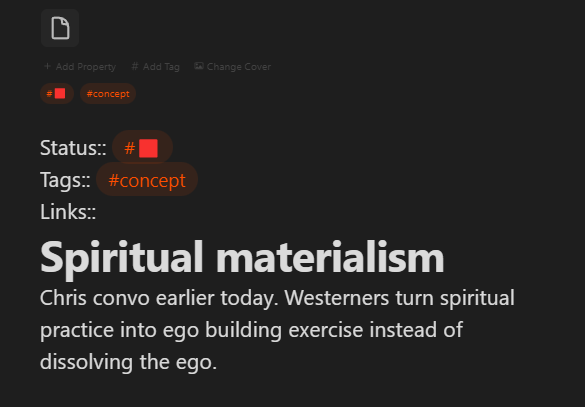
📚How to Create Literature Notes
Literature notes are created in your literature notes folder.
You can automate this through using Readwise, some other automation platform, or through manually adding your literature notes into Obsidian. I recommend differentiating between different types of literature like podcasts, videos, blogs, academic articles, lectures, etc.
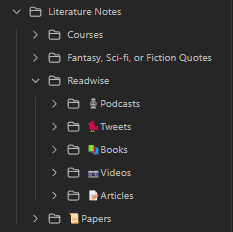
My literature notes have a tag showcasing the inbox image if they have not been processed yet.
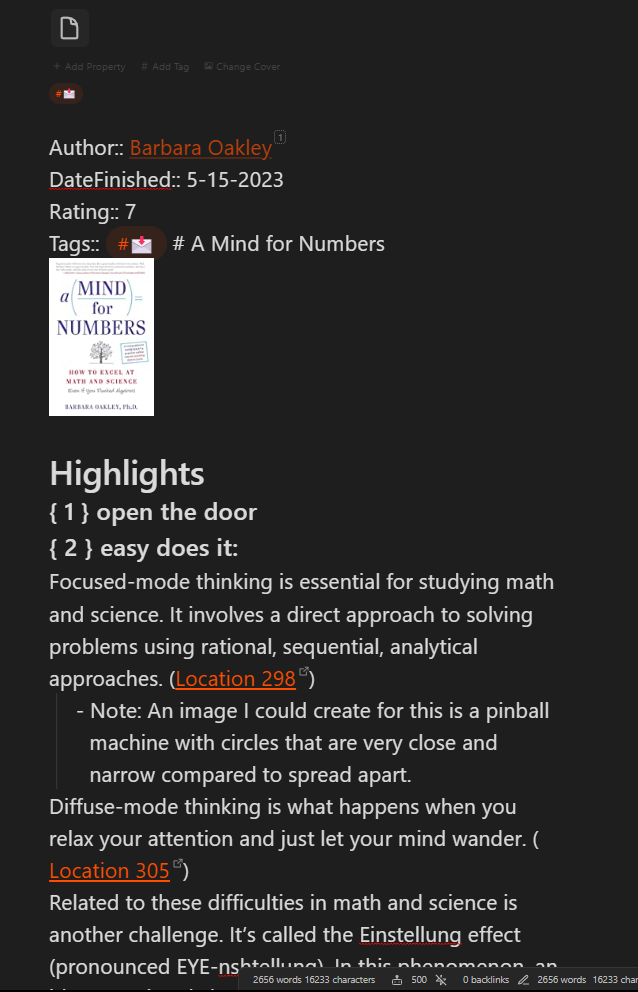
The best way I have found to process literature notes and create concept notes with them is to make it a habit.
So everyday, for 15 minutes usually in the morning I will go through my literature notes that need to be processed and create concept notes. This is the single highest leverage habit you can build toward your zettelkasten. This seemingly small amount of time spent processing literature notes is how you create a notetaking system that scales across semesters.
💡How To Create Concept Notes
Concept notes are created from the mixing of your own ideas with those of your literature notes from podcasts, lectures, books, videos, etc.
Concept notes are stand alone notes that focus on one idea. My favorite way to create them is to word them like statements. For example, my concept note everlasting happiness comes from living a life in accordance with virtue.

This is an idea I had after reading Marcus Aurelius's Meditations and Siddartha by Herman Hesse.
It became a concept note, a meshing of the ideas from the book alongside my own ideas.
Notice how it focuses only on one idea, that everlasting happiness comes from living a life in accordance with virtue and links out to other concept notes in my system.
If you want to learn how best to create and connect your concept notes, I suggest checking out my in-depth article, 5 Simple Methods For Growing Your Concept Notes In Obsidian.
Congratulations!
You now know the three most important notes that make up a Zettelkasten and the habit that will allow you to create them.
Now it's time to learn how to connect these notes.
Connect
Connect is where the true fun of building a Zettelkasten comes into play.
This is where you start connecting your concept notes together and growing a unique knowledge base that scales across semesters.
In the article, you will learn the 5 methods I use to connect concept notes in my Zettelkasten over time.
🗺️MOCs
As you grow your vault with literature notes, create concept notes, and connect them together, there will come a point where the amount of notes in your system becomes overwhelming.
You will want a way to navigate the incredible amount of information that is coming up.
This is the stage where you create MOCs, which go into the Atlas folder mentioned earlier.
A map of content is one note linked to other related notes to create a map.
That simple.
Here are some examples of MOCs in my Obsidian system:
What are the benefits of creating a MOC?
- MOC organized systems reduce the need for folders and tags. Instead, you can use links as your primary organization feature.
- MOCs allow you to see the relationship between seemingly unrelated ideas.
- MOCs allow you to think bottom-up and top-down. When growing your concept notes, you can grow them from the MOC note itself or the individual note level.
- MOCs allow you to think and link first and organize in other ways later once the disorganization becomes overwhelming.
- MOCs allow you to grow your notes while staying in flow. Starting from the MOC as a foundation, you can dive into any note, grow it until you don't know what to do, and then return to the MOC view to jump in and grow another note. In effect, you cannot make it for hours longer.
When Do You Create a MOC?
There are generally two starting points for MOC creation:
- You already have the notes for your MOC, and now you're building it up.
This could happen after you hit a mental squeeze point and notice a collection of ideas in your vault, or you're migrating from another system into Obsidian and already have a ton of notes you want to create MOCs out of.
- The second starting point is you have no notes, and you building the MOC over time.
If you want to learn more in-depth how to create MOCs for yourself, check out 5 Simple Levels To Supercharging Your Learning With MOCs In Obsidian.
The connecting of concept notes and the building of MOCs is the core method through which you will start to build a unique knowledge base that scales across semesters inside of Obsidian.
Create
Creation is all that matters.
The collecting and connecting you have done nothing without creation. Creation is where you put knowledge into action. It's where you put your learning to action.
There is no faster way to learn than applying new knowledge.
But there's another reason creation is incredible.
It allows you to compound your knowledge. Your past self forms the building blocks of future work.
Your unique knowledge base compounds over time.
It doesn't matter if you don't want to be a content creator; creating things as a student is the fastest way to learn and benefit from the compounding effect.
The first thing you will learn is the three-step process I use to create any writing-related product.
Using this 3 step process, I have created in just two years:
- 170 YT videos
- 350 literature notes
- 60 Newsletters
- 60 Blog Posts
- 10 School MOCs
- 12 Non-School MOCs
- 20 Podcast Episodes
The secret:
I simply connect old creations with concept notes inside of my Zettelkasten.
Most of the time 80% of a piece of content is already finished, and I just need to do the last 20%.
All with a simple 3-step process:
- Dump
- Lump
- Jump
I use this 3-step process for creating anything.*
Writing college essays, YouTube scripts, blog posts, newsletters, course outlines, MOCs, and more. This is the process I wish I had two years ago. Now you get to learn it in the next five minutes.
Remember, though, this process is simple. That doesn't mean it's easy.
You still have to do the work.**
Dump, Lump, Jump
The 3 step process is called dump, lump, jump.
In summary, it works by dumping all of your ideas for a given creative project down in a document. Then lumping them together under themed points. And finally, copying and pasting the content of the individual notes and pasting them into the document.
Let's see this process in action using an essay prompt I got for my class on the psychology of making better decisions for life, love, and money.
The essay prompt: Take your greatest insights from Daniele Gilbert's book Stumbling on Happiness and analyze how they have changed your life in some way.
Dump:
First, I dump every idea, quote, or note I think would be relevant to the essay.
Everything.
As you do this process more and more, you will get better at sifting what you should dump versus what you leave out. But in the beginning, you should follow your gut. This is where you finally get to experience the true power of link-based thought. As I paste relevant notes into the document, I follow the connections I created in the past through the back links view, the local graph, and the notes themselves.
This gives you a foundation for the essay.
As your dump more and more into the note, you will get a better and better idea of what to write about. Start fleshing out a title for your creative work (in this case, an essay). Spend a good amount of time on this. The title gives an idea of how the lump stage will go. You can even write a short introduction if you want to.
Here is the result of five minutes of dumping for the essay:
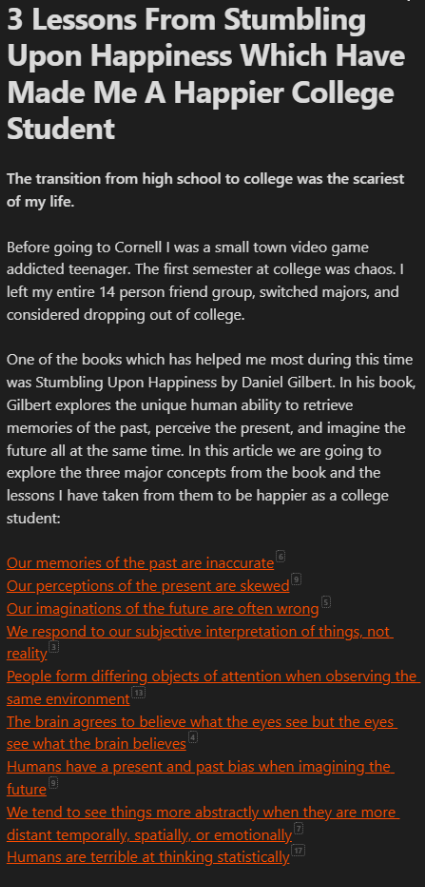
Lump:
In the lump stage, you take all of your dumpings — you better thank me for not making a poop joke — and lump them together based on a theme.
This is why the titling is so important. An essay titled "3 Questions" vs. "3 Lessons" will have an entirely different outline. Your lumping become the outline for your essay.
In my case, lumping led me to realize I wanted to structure my lessons around the three main insights of the book:
- Our memories of the past are inaccurate
- Our perceptions of the present are skewed
- Our imaginations of the future are often wrong.
I put the relevant dumpings under each header in my outline. This was the result of five minutes in the lump stage:
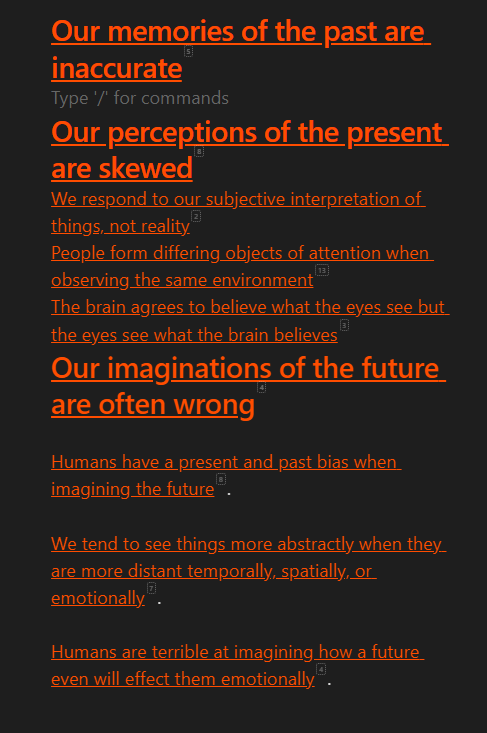
Jump:
In the jump stage, you copy and paste the contents inside each note and bring them into your document.
Here's what a part of my essay looked like right after the jump stage:
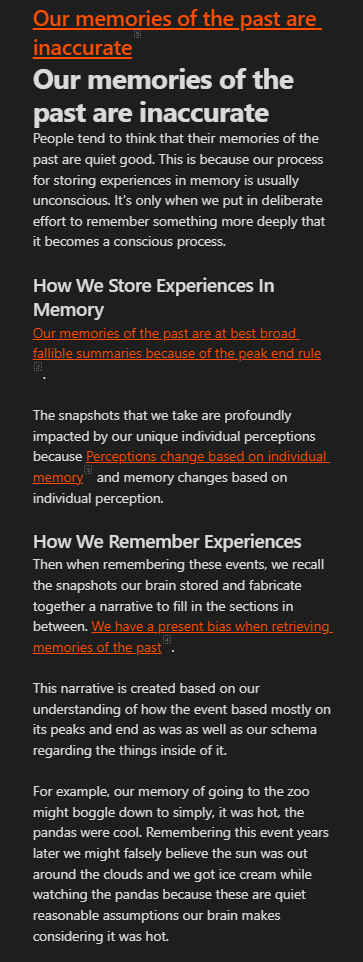
Then, the only thing left to do is write, which involves three things:
- Reword and reframe the note content to fit with the specific work
- Connecting together what you have into a narrative
- Finding holes in your argument and identifying areas for further research
All in all, writing this 2000-word essay took me around an hour.
That's the power of conceptual note making.
Most of the work comes in collecting and connecting information. When you sit down to write, you should be 80% done already. You never have to start with a blank page again.
Integrating Zettelkasten with College Studies:
The Zettelkasten can be seamlessly integrated into your coursework and studies.
Incorporating Zettelkasten Into Coursework
It can be integrated into coursework and research projects.
If you want to learn how to do so, I would recommend checking out my two articles: The Four Step MOC Creation Process I Use to Maximize Understanding of my College Classes in Obsidian. My Step By Step Process For Taking Conceptual Lecture Notes
Using Zettelkasten For Exam Preparation And Studying
It can be integrated into your studying practice and exam preparation as well.
If you want to learn how to do so I would recommend checking out my good Obsidian friend John Mavricks video on how to create flashcards out of your concept notes.
How To Change The Zettelkasten For If Your a STEM or Humanities Student
While the core principles of Zettelkasten note-taking remain the same, there can be some variations in how humanities and STEM (Science, Technology, Engineering, and Mathematics) students apply the method.
Here are a few considerations for each discipline:
Humanities Students:
- Emphasis on interpretation and analysis: Humanities subjects often require critical analysis, interpretation of texts, and exploration of abstract concepts. Humanities students may focus on capturing nuanced interpretations, key quotes, or themes in their Zettelkasten. They may also include references to influential thinkers, theories, or philosophical frameworks.
- Interdisciplinary connections: Humanities students frequently draw connections between various disciplines, such as literature, history, philosophy, and cultural studies. Their Zettelkasten may reflect interdisciplinary exploration, linking ideas from different domains and creating a rich tapestry of interconnected concepts.
- Citations and references: Humanities students often engage with extensive academic literature, requiring meticulous citation management. Integrating citation information or bibliographic details within their Zettelkasten can be crucial for proper attribution and referencing sources.
STEM Students:
- Focus on scientific principles and formulas: STEM subjects rely on scientific principles, mathematical formulas, and empirical evidence. STEM students may capture key formulas, equations, and experimental methods in their Zettelkasten. They may also document scientific concepts, definitions, and empirical findings.
- Problem-solving and algorithms: STEM students frequently encounter problem-solving scenarios and algorithmic procedures. They may create Zettelkasten notes specifically dedicated to problem-solving techniques, step-by-step algorithms, or coding snippets. These notes can serve as valuable resources for future reference and application.
- Experimental design and data analysis: For STEM students involved in research or lab work, documenting experimental designs, methodologies, and data analysis techniques is important. They may include notes on statistical analyses, research protocols, or data visualization methods within their Zettelkasten.
- Visualization and diagrams: STEM subjects often benefit from visual representations such as diagrams, charts, and graphs. STEM students may incorporate visual elements within their Zettelkasten, creating visual aids to understand complex concepts or illustrate relationships between variables.
Regardless of the discipline, both humanities and STEM students can benefit from the core principles of Zettelkasten, such as organizing knowledge, making connections, and promoting active learning.
Troubleshooting and Tips For The Zettelkasten
3 Biggest Mistakes Students Make Starting an Obsidian Zettelkasten in College
There are a lot of beginner mistakes to starting an Obsidian Zettelkasten in college.
Out of all of them, however, these are the three biggest traps:
- Not connecting notes between classes and semesters together
- Not connecting your class notes to your own learnings
- Not creating MOCs out of your class notes
1. Not Connecting Notes Between Classes And Semesters Together
When first creating a Zettelkasten, it can be easy for students to fall back into the sequential notetaking style they are so used to from more traditional notetaking methods.
But the power of a Zettelkasten comes in the connection between seemingly unrelated ideas. For example, connecting a note from Introductory Biology about recessive genes to your History note on the massive chins of the Old English Aristocracy caused by incest. You have to make sure that you connect notes between classes and semesters together.
To remind myself of this, I reflect on this quote regularly:
"There are no rigid disciplines in the universe, only concepts."
All disciplines — Biology, Neuroanatomy, Behavioral Statistics, American History, etc. — are just highly related concepts linked together into a coherent and more easily digestible form. It's through the linking of these highly related concepts, from class to class from semester to semester, that your knowledge base starts to grow. Your Zettelkasten becomes more than the sum of its individual parts.
Your knowledge compounds over time.
2. Not Connecting Your Class Notes To Your Own Learnings
Many beginner Zettelkasteners — it's a word now I made it up — think their learnings inside class are separate from their learnings outside class.
As a result, they separate their class notes in Obsidian from their notes on Podcasts, books, blog posts, and more. But as said earlier, the power in a Zettelkasten comes from connecting ideas together and scaling them over time. Your personal learnings can only help in this process.
In fact, it will likely only make you more interested in your learnings inside of class. Double Whammy!
3. Not Creating MOCs Out Of Your Class Notes
As your Zettelkasten grows throughout the semester, your class notes will soon start to become overwhelming.
Some notes are connected to other notes, but there is no clear map for the class. The mistake is to leave them floating in the depths of the nether realm. This will only guarantee you never touch them again and don't form an accurate mental model of the class.
The solution is to create the Maps of Content (MOCs) out of your class notes discussed earlier.
There are many, many more beginner mistakes to starting a Obsidian Zettelkasten in College. But avoid these ones, and you will stay away from the worst of the traps.
6 Tips For Maintaining a Healthy and Sustainable Zettelkasten Practice
- Make Growing Your Zettelkasten a Habit: One of the highest leverage habits I instilled to work on my Zettelkasten was to make it a daily quest to process and grow my notes for 15 minutes a day. I usually do this in the morning. This 15 minutes doesn't seem long, but over the long run, it compounds to insane degrees.
- Have Some Fun With It: Growing a Zettelkasten is going to be hard at first. It goes against the Cookie Cutter way we have been taught to take notes since we were a kid. So enjoy the journey of learning.
- Epic Efforts Over Projects: It's not about the number of notes you collect but the quality of the loot you find! Focus on the journey of crafting high-quality, powerful notes that capture the essence of an idea.
- Reflect, Respawn, and Respec: Take time to reflect on your Zettelkasten journey. Just like in a video game, evaluate your skills, techniques, and workflows. Experiment with different strategies, re-spec your note-taking approach and level up your Zettelkasten game. Adapt your playstyle to optimize your knowledge management. Don't assume the way I grow my Zettelkasten is automatically the best way.
- Beware Of The Collectors Fallacy: one of the most common traps students fall for when building a Zettelkasten as they collect too much information into their system without using it for anything. You can avoid this not only by collecting less things but having a bias for creation.
- Take notes on one area of interest and start from there. On the other end of the spectrum, a common problem is students don't know where to start taking notes. In this case, I recommend you choose one area of interest from looking at previous things you have consumed and start there.
The Zettelkasten Transformation
If you implement the workflow and mindset of the zettelkasten for at least two years, I promise your life will change dramatically.
Why two years? There's no magical reason. Following through with anything for more than two years is bound to show results of some kind.
I doubt you will be disappointed if you do.
You will start to see ideas as an interconnected network and conversation between different people, a conversation you can join at any place, wherever your interests lie.
Over time everything will start to make sense, as you can see mapped notes, projects, and new ideas forming under the structure of your everyday life. Your mind will change, learning to work symbiotically with your second brain to draw on resources, references, and research far beyond what it can remember on its own. You become more objective and unattached, knowing if an idea doesn't work out, you have a treasure trove of others ready to go. Your zettelkasten becomes an externalization of your psychology, a mirror reflecting who you think you are, who you want to be, and who you want to become.
Because you have a PKM workflow, every experience becomes an opportunity to learn and grow.
People will notice.
They'll see you can draw an unusually large body of knowledge at a moment's notice without realizing you never set purposeful time to remember anything. They will admire the fluidity and interestingness of your ideas without realizing your zettelkasten makes them come organically. They'll respect your avid expression without realizing it's so much easier when you never have to start from scratch again. They will see the genuine joy and curiosity you show toward everything in life. Then they will become curious about what you are doing differently. Finally, they will make their own PKM journeys.
In this way, PKM is not only the art of changing your relationship to information but changing others as well.
If you want to learn more, check out my and fellow Obsidian creator John Mavrick's flagship notetaking course Obsidian University: Your Secret Weapon In School. In it, you will:
- Learn how to find enjoyment in learning and studying by breaking out of the Cookie Cutter Mindset
- Flesh out a systemized process for taking notes on class lectures and outside learnings
- Create a unique personal knowledgebase inside Obsidian that scales across classes and semesters
- Learn how to study using your Obsidian notes
- Gain access to a community discord with fellow students looking to make the same transformation
Here's what I would like to share this week.
📸News From The Channel!
📺Latest On De YouTube - Seven Powerful Tips For Cultivating Intrinsic Motivation In College From Burnout to Bliss: Cultivating intrinsic motivation is the most powerful way to healthily and more effectively do something over the long. In this video, I discuss seven powerful tips to cultivate intrinsic motivation at college.
🎙️Latest On De Podcast - E19 Bianca Pereira: How To Unveil Your Inner Researcher In PKM: Bianca Pereira is a researcher and educator and has built the Prolific Researcher community with the goal of making research easy. She helps writers think like a researcher and build their own low-friction workflow to capture, organize and grow their ideas into research-based content. In this episode, you will learn:
- How to adopt the mindset of a researcher into your PKM workflow
- Why you should add your unique perspective and interests to your notes
- Why you should link together notes at the atomic level
💡My Best Insights:
- 🎙️Podcast - Ep. 31 — RYAN HOLIDAY on Ranch Life, Fostering Discipline, and the Loss of Reading Culture: When you take notes and connect them to ideas you had in the past, you make open yourself up to using your past selves work for your present self. Marking down a book in the moment, you might not know what it's going to be used for. But years from then, you might go back to that note and find it incredible for something you are working on. Another interesting insight from this podcast is that perfectionism is most rampant when you are at a standstill because that's when you have the mental bandwidth to think about all the ways something could be better. When you act, it's difficult to let perfectionism overrule you.
- 📖Book - Happiness Beyond Thought by Gary Weber: This book gives clear methods on how we can use breathing, meditation, yoga, and chanting to quiet the endless storm of thoughts coming into our minds. It heavily influenced the book, The Victorious Mind, which I wrote a previous newsletter on, and there's a reason it did.
- 📺YouTube Video - Live Sensemaking Session with Nick Milo: During this video, Nick Milo shows us how he note makes inside of Obsidian. He discusses the mindsets, methods, and tools that he uses to do so.
- A personal essay targeted towards college students in the realm of gamification, relationship psychology, or Obsidian Personal Knowledge Management
- A curated list of everything that has come out on my content channels
- A curated list of my coolest learnings over the past week
In addition, consider checking out my digital notetaking course Obsidian University to help students like you build a notetaking system that compounds your school learning across semesters.
